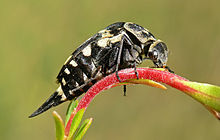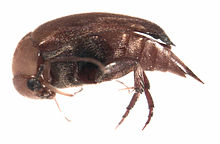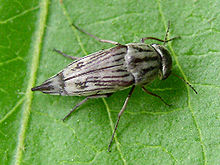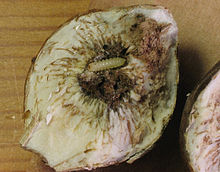- Mordellidae
-
Tumbling flower beetles 
Imago of unidentified species; note the "pintail" Scientific classification Kingdom: Animalia Phylum: Arthropoda Class: Insecta Order: Coleoptera Superfamily: Tenebrionoidea Family: Mordellidae
Latreille, 1802Subfamilies Ctenidiinae Franciscolo, 1951
Mordellinae Latreille, 1802
†PraemordellinaeSynonyms Liaoximordellidae
Mordellidae is a family of beetles commonly known as tumbling flower beetles for the typical irregular movements they make when escaping predators, or as pintail beetles due to their abdominal tip which aids them in performing these tumbling movements. Worldwide, there are about 1500 species.[1]
The apparently tumbling movements are composed of a series of very rapid separate jumps (each jump of a duration of approximately 80 ms). They result from the beetle's efforts to get itself back into take-off position for flight when it has been in either lateral or dorsal position. Each individual jump should be considered as an extended rotation, performed by one leg of the third leg pair (Metapodium ). Depending on whether the left or the right metapodium is used as the leg that provides the leverage for take-off, change occurs in the direction of the jump. The energy for propulsion varies with the beetle's immediate muscle work. Resultantly, jump lengths and heights vary, with rotation frequencies recorded up to 48 rotation per second (Mordellochroa abdominalis) around the gravitation centre of the body's longitudinal axis. Additional revolving round the transverse axis (at lower frequency) effects spiralling summersaults that are perceived as tumbling. The pintail (pygidium) is of no significance for the jump. Technically similar jumps, though less powerful, can be observed in family Serropalpidae (genus: Orchesia) and family Scrabtiidae (genus: Anaspis). As both these groups of beetles are closely related to family Mordellidae, it may be assumed that it is due to their common phylogenetic roots that they have the same capacity of this tumbling form of locomotion. It can, therefore, not be ascribed specifically to Mordellidae. [2]
Contents
Systematics
 Adult female Tolidopalpus nitidicoma (Mordellinae: Mordellistenini) from lateral
Adult female Tolidopalpus nitidicoma (Mordellinae: Mordellistenini) from lateral
This family has two living subfamilies – Mordellinae and Ctenidiinae – and a prehistoric one known only from fossils (Praemordellinae). Another fossil genus, Liaoximordella, was previously treated as distinct monotypic family Liaoximordellidae, but is now regarded as very primitive and probably basal member of the Mordellidae.
Selected genera
-
This list is incomplete; you can help by expanding it.
Genera of tumbling flower beetles, with some notable species also listed, include:
Basal/incertae sedis
- †Liaoximordella Wang, 1993 (fossil)
†Praemordellinae (fossil)
- †Bellimordella Liu, Zhao & Ren, 2008
- †Mirimordella Liu, W.Lu & Ren, 2007
- †Praemordella Scegoleva-Barovskaja, 1929
Ctenidiinae
- Ctenidia Laporte de Castelnau, 1840
Mordellinae
Tribe Conaliini Ermisch, 1956- Conalia Mulsant and Rey, 1858
- Glipodes LeConte, 1862
- Isotrilophus Liljeblad, 1945
- Pseudoconalia
- Xanthoconalia
Tribe Mordellini Latreille, 1802
- Glipa LeConte, 1859
- Hoshihananomia Kôno, 1935
- Mordella
- Paramordellaria Costa, 1854
- Tolidomordella Schilsky, 1908
- Tomoxia Ermisch, 1968
- Variimorda
- Variimorda villosa
- Yakuhananomia Ermisch, 1950
Tribe Mordellistenini Latreille, 1802
- Falsomordellistena Ermisch, 1941
- Glipostenoda Ermisch, 1950
- Mordellistena Costa, 1854
- Mordellochroa Emery, 1876
- Pseudotolida Ermisch, 1950
- Tolidopalpus Ermisch, 1952
Tribe Reynoldsiellini Latreille, 1802
- Reynoldsiella
Tribe Stenaliini Latreille, 1802
- Pselaphostena Franciscolo, 1950
- Stenalia
- Stenaliodes
Footnotes
References
- Ivie, Michael A. (2002): [Mordellidae]. In: Arnett, Ross H. & Thomas, Michael Charles: American Beetles (Vol. 2: Polyphaga: Scarabaeoidea through Curculionoidea). CRC Press. ISBN 9780849309540
External links
Categories: -
Wikimedia Foundation. 2010.


